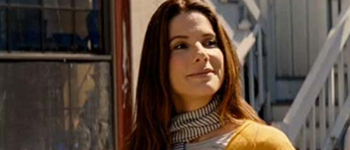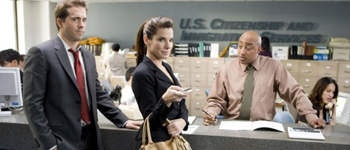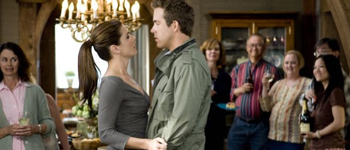
CJ Powers is an author/speaker
residing in the Chicagoland area. As a Writer/Director/Producer he
is an international script consultant and conducts screenwriting
workshops. His films released internationally and television programs
aired on CBS, PBS, ABC, the Family Channel, and various syndicated
stations. The majority of CJ’s directing awards, including the Silver
CINDY and Crystal Communicator of Excellence, were for family films. He
received additional honors from the U.S. and International Film and
Video Festival and the New York Film Festival. He is a guest writer for
Christianity Today’s
Singles Connection eNewsletter and has also been an Arts &
Entertainment columnist for the DuPage Christian.
|
Analyzing Conflict within Your Script |
|
Conflict is king of the silver screen, and a story will die in a few minutes without it. It is the cornerstone of a great drama, and even comedies have enough conflict in them to drive the plot forward. In the case of The Proposal, one of the top box office movies this past summer and in the top ten grossing Romantic Comedies of all time, conflict is embedded in every scene of the film. The conflicting pulse of The Proposal comes from Margaret Tate (Sandra Bullock), a high-powered book editor who has mutually exclusive goals from her quick-thinking executive assistant, Andrew Paxton (Ryan Reynolds). Throughout the film both try to maintain control or power through various forms of inner, relational, societal, situational, and religious conflict. To analyze the conflict within a screenplay, it is important to understand how the different types of conflict are demonstrated visually. Inner Conflict  Inner conflict typically comes out through a character who is unsure of herself. Margaret finds herself determined to use Andrew to avoid deportation, but during the middle of the fake wedding charade, she remembers what it was like to have a sense of family. Conflict can be built when a character is unsure of her desires, actions, or thoughts. It can be presented visually as she suffers through what she truly wants versus what she thought she desired. The more the conflict is demonstrated through visuals, the stronger the story; however, many times a writer will take the easy way out by expressing the inner conflict through dialoguing with a confidant. Relational Conflict  The most common form of screen conflict is relational because the interaction of two characters tied together with pithy dialogue can do wonders for the story, while driving the plotline forward. Typically, the protagonist has mutually exclusive goals from the antagonist, and the playing out of both simultaneously forces conflict to erupt on-screen from within the development of each character. In The Proposal, Andrew has his heart set on being an editor and is willing to put up with just about anything from Margaret to achieve his goal, even getting married to her for a time so she won’t be deported. Margaret also has a goal of not being deported and sees nothing wrong in using her executive assistant to facilitate her staying in the States. Once Margaret remembers what it is like to be a part of a family, her goal changes to help keep Andrew’s family intact, even at the expense of her own career, which is just when Andrew’s goal shifts to wanting to marry Margaret for real—keeping the conflict going until the final scene. Societal Conflict  Societal conflicts usually take the form of the little guy or underdog going up against the giants of society or the system. A few memorable films that fit this category include The African Queen, Out of Africa, Gone with the Wind, or Moon (released this past summer). The character of Margaret trespassed on many sacred, but minor, societal issues like speaking offensively about Hispanics, cutting in line because she was more important than the little people whom she passed by, and offending those from a small town lifestyle. Many of those issues were resolved by the end of the story to show growth in Margaret. The funniest resolution was the small-town, servant-oriented Hispanic who officiated at her wedding. Situational Conflict 
|
Situational comedies were huge during the ’80s and still survive today. Buster Keaton and Charlie Chaplin kicked off a long-running formula that has shifted over the years but sustained many laughs and conflicts. Today, situational conflicts are temporary and can’t sustain an entire film, but they can salt in nicely to move the characters into another level of expression. Margaret’s chasing after the eagle that took her cell phone and offering Andrew’s mother’s dog as a peace offering demonstrated her conflicts between being a kind warmhearted person versus a cold business professional. Other situations included carrying heavy luggage on gravel while wearing high heels, climbing down a dock ladder while wearing a power suit, and falling off of a speedboat. Each situation allowed the writer to reposition the character for more growth. Religious Conflict  Sandra Bullock rarely has religious conflict within her movies, since she knows not to offend her fan base. However, Betty White’s role had a moment of giving spiritual thanks to mother nature, which not only presented conflict for Sandra’s character, but also gave her a moment to explore some funny expressions of letting go of one’s inner self. These expressions are usually difficult to visualize because they reside deep within the character’s heart. On rare occasions a film might explore a conflict between man and God, or God and Satan. In a few Star Trek movies, the conflict arises from a god-like alien or supernatural force that battles against the protagonist. In any case, the writer needs to find a way to visualize the character’s goal. The idea is to project the character’s problems with an invisible source onto someone who just happens to be in the way. This situation gives visibility to the inner issues for understanding. Central Conflict  While numerous forms of conflict were used to drive the storyline, the overarching central conflict embedded into the action plot was launched the moment Andrew agreed to participate in the marriage charade under a few conditions of his own. This reoccurring conflict generated an impromptu wedding ceremony, a federal official hot on their trail, numerous comedic, fish-out-of-water situations, and all the relational issues of Margaret and Andrew’s reluctantly sticking to plan despite the precarious consequences. If the conflicts were pulled out of the story, nothing of significance would remain. It is therefore critical to find the conflict within each scene of the screenwriter’s script. Every time I read a script, I make a notation using the arrow keys pointing at each other to represent conflict. On each side I write who is involved in the conflict and what motivations conflict. I use a colon to separate the characters from the actions. ANDREW >< MARGARET: Andrew pressures Margaret to promise him an editor’s position and propose nicely in order for him play out the marriage charade >< Margaret pressures Andrew to join the charade and warns him of his imminent job loss if she is deported. Margaret eventually succumbs to Andrew’s pressure and proposes, sending the story off into Act 2. Conflict is the heartbeat of The Proposal, reminding me that conflict is king of the silver screen. Copyright © 2009 By CJ Powers. All material from The Proposal (2009) is Copyright © Touchstone Pictures. All Rights Reserved. CJ Powers can be reached for script consultation and translation work at cjpowers7[at]gmail [dot] com. |







